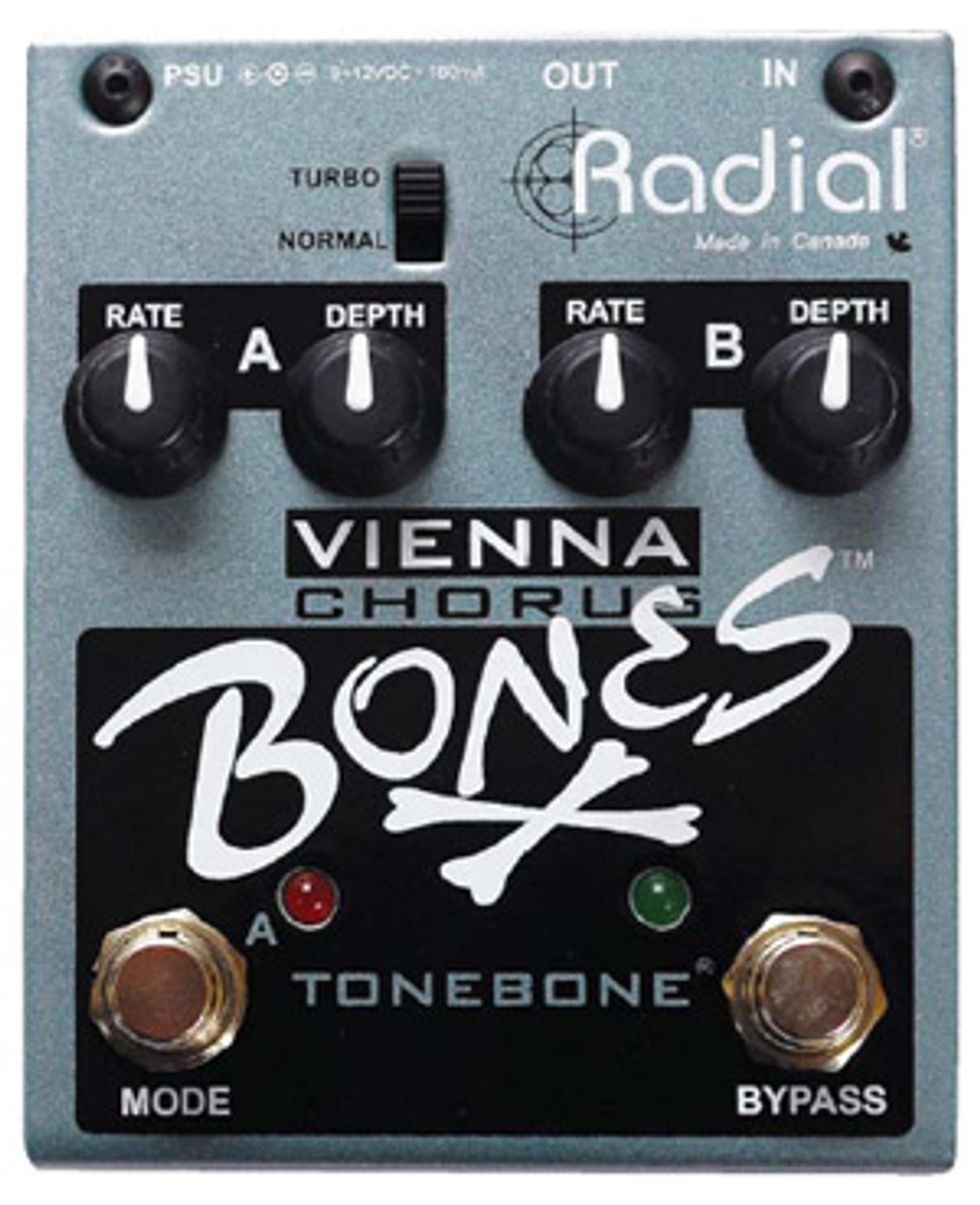 | |
| Download Example 1 Channel A; Rate: 8 o'clock, Depth 2 o'clock, Channel B; Rate 4 o'clock, Depth 10 o'clock | |
| Download Example 2 Turbo Switch 'On' Channel A; Rate: noon, Depth: 10 o'clock, Channel B: Rate: noon; Depth 4 o'clock | |
| All tracks recorded with a humbucker-equipped Gibson Les Paul and a 1966 Fender Bassman | |
Canadian Rock
You can almost distinguish a Radial pedal with your eyes closed. Few stompboxes have the heft of a Radial device, and it instills a lot of confidence in the Vienna’s roadworthiness. Though the somewhat busy graphics and a control set that includes a slider switch, four knobs, and two footswitches makes the pedal look complicated, it’s actually very straightforward and easy to use.
One footswitch engages the effect, while the other switches between the pedal’s two modes. Two knobs are dedicated to each mode, which, like most chorus or vibrato effects, enable control of modulation depth and rate. The slider switch moves between Normal and Turbo settings, which affect the intensity of the modulation.
The Vienna’s dual-mode circuit is designed around NOS Panasonic MN3007 bucket brigade chips from the early ’80s, which gives the pedal a genuine analog chorus pedigree. But you can’t use a 9-volt battery to power the Vienna. To get this unit working, you’ll need a standard Boss-style 9-volt adapter.
Quiet and Clear
I explored the Vienna’s many modulation options using a very clean combination of a blackface Fender Tremolux, a Danelectro Hodad 12-string, and a Rickenbacker 330 run through a JamMan so I could evaluate the Vienna’s dual-mode setup. On its first channel, I dialed in a very mellow, slow chorus and on its second, a fast and deep setting.
Playing a mid-tempo, shoegazey set of arpeggiated chords suited the slow setting perfectly. And the Vienna added a pleasing, hazy swirl that gave the chiming tones of the Rick and the Danelectro a little more body. Once I’d looped the pattern, I kicked on the second channel and added some droning, fast chorused leads over the top. Even in the fairly busy sonic environment I’d just created, the liquid, and delightfully queasy, rotary speaker-like sounds popped out of the mix in brilliant detail.
Switching to the Turbo induced even stronger, more radical modulations that sounded especially demented over the slower loop when I kicked on a Rat I put in front of the Vienna. Even driven with the super-hot Rat-tortured signal, the peaks and sweep of the Vienna’s chorus—often evocative of tape warble—remained intact an detailed.
Radial is famous for their very quiet circuits. And their expertise in creating them for use in acoustic instrument preamps and DI boxes pays off in the Vienna chorus too. The inherent quiet of the signal means you can afford to create more radical modulated environments without losing picking nuance or the sonic qualities of other pedals in a muddy sonic whirlpool. And needless to say, the exceptionally quiet nature of the Vienna makes more delicate and subtle applications of the effect a delight.
The Verdict
Like any Radial box, the Vienna is a top-quality piece of gear that’s built to handle the road, the stage, and the studio. The pedal’s dual-mode design also makes the Vienna a very flexible effect. You can create everything from a lazy, watery rhythm to radically pulsing and acidic leads in the same song on the fly, without changing any settings. And with a circuit this quiet, it’s a pedal you can use with confidence in almost any musical context—especially those calling for a touch of rotary speaker mojo on the cheap or something far more surreal.
Buy if...
you need a sturdy, quiet, roadworthy chorus that can move from subtle to psychedelic with a single stomp.
Skip if...
you can get by with a less flexible digital chorus.
Rating...
Street $159 - Radial Engineering - tonebone.com |
| Tone Games 2010: 30 Stompboxes Reviewed | Next in MODULATION: Tortuga Effects Martini Dual Analog Chorus and Vibrato |







![Rig Rundown: Russian Circles’ Mike Sullivan [2025]](https://www.premierguitar.com/media-library/youtube.jpg?id=62303631&width=1245&height=700&quality=70&coordinates=0%2C0%2C0%2C0)

















